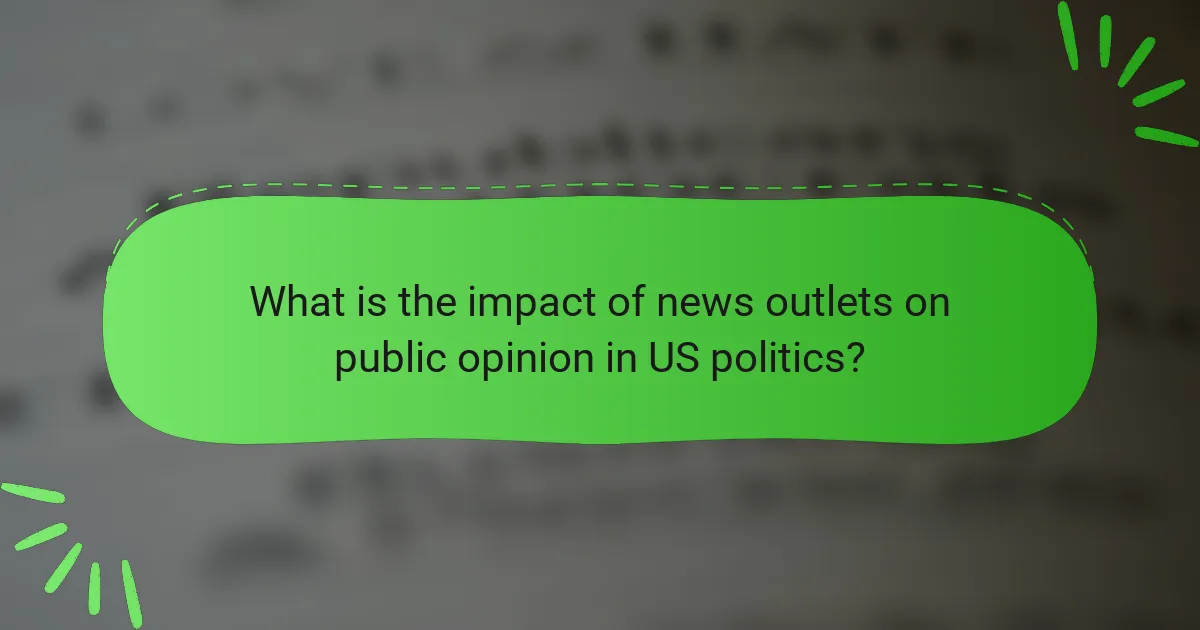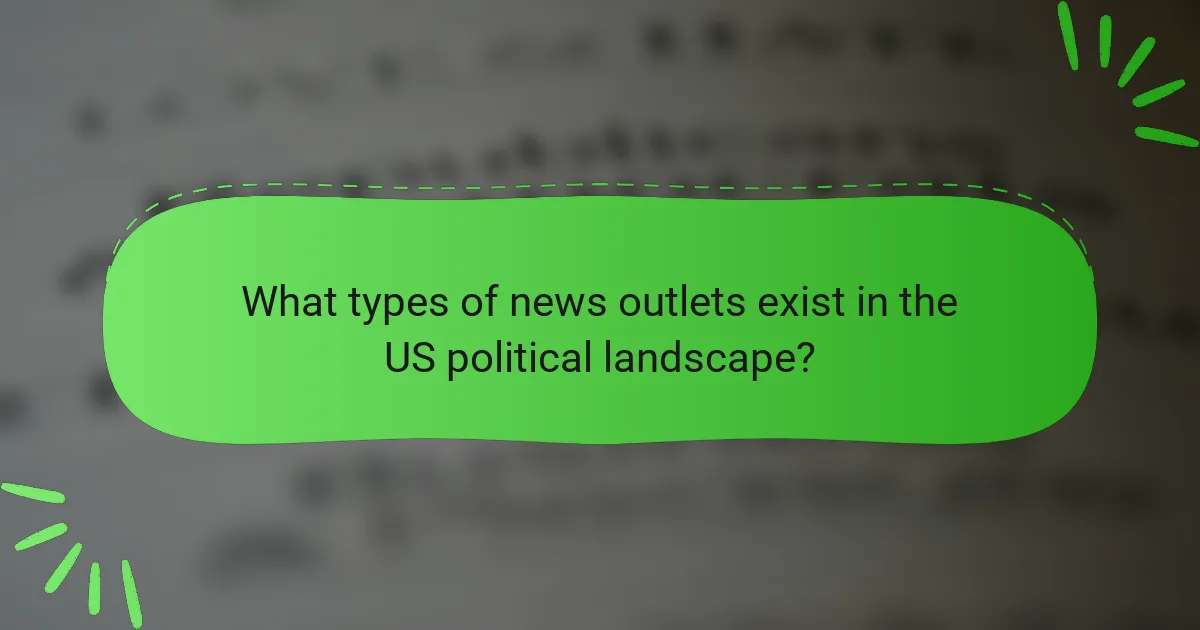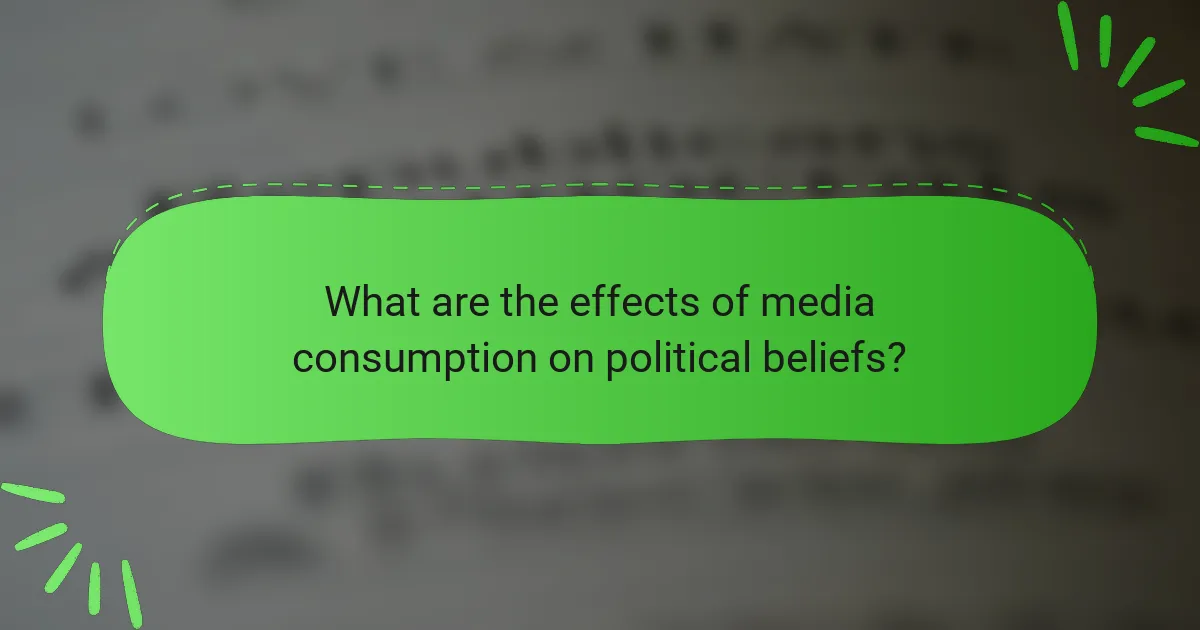News outlets play a pivotal role in shaping public opinion within the United States political landscape. They influence perceptions of political issues, candidates, and policies through mechanisms such as framing and agenda-setting, which determine the topics that receive public attention. Traditional media, including newspapers like The New York Times and television networks such as CNN, alongside digital platforms like BuzzFeed News, contribute to this dynamic. Research indicates that media consumption patterns can reinforce existing political beliefs and increase polarization, particularly when individuals engage predominantly with partisan outlets. Overall, the impact of news outlets on public opinion is significant, as they inform and influence the political attitudes of the American populace.

What is the impact of news outlets on public opinion in US politics?
News outlets significantly shape public opinion in US politics. They influence perceptions of political issues, candidates, and policies. Through framing and agenda-setting, news outlets highlight specific topics, affecting what the public considers important. For instance, studies show that increased coverage of an issue leads to greater public concern about that issue. According to a Pew Research Center study, 62% of Americans believe news organizations are critical for democracy. Furthermore, partisan news outlets can deepen political polarization. Research indicates that individuals exposed to partisan media are more likely to adopt extreme political views. Overall, news outlets play a crucial role in informing and influencing the political landscape in the United States.
How do news outlets shape public perception of political issues?
News outlets shape public perception of political issues by selecting which stories to cover and how to present them. They influence the agenda by focusing on specific topics and framing them in particular ways. For example, the framing of healthcare issues can emphasize either costs or quality of care. This affects how the public perceives the importance of these issues. Research shows that repeated exposure to certain narratives can lead to a shift in public opinion. According to a study by the Pew Research Center, 62% of Americans believe news coverage influences their views on political matters. This demonstrates the significant role news outlets play in shaping political discourse.
What role do news outlets play in framing political narratives?
News outlets play a crucial role in framing political narratives. They shape public perception by selecting specific topics for coverage. This selection influences which issues are viewed as important. Additionally, the language and imagery used in reporting can evoke particular emotions. Research shows that framing can affect public opinion and voting behavior. For instance, studies indicate that negative framing of political candidates can lead to decreased support. Furthermore, news outlets often provide context that can sway interpretations of events. This power to frame narratives positions news outlets as key players in the political landscape.
How does the selection of news stories influence public opinion?
The selection of news stories significantly influences public opinion by shaping perceptions and attitudes. News outlets prioritize certain stories, which can lead to a focus on specific issues over others. This selection process affects what information the public receives and how they interpret it. For example, framing a story in a particular way can evoke emotional responses. Studies show that exposure to specific news narratives can alter public perceptions on topics like immigration or healthcare. The agenda-setting theory supports this, indicating that the media doesn’t tell people what to think, but what to think about. Consequently, the selection of news stories plays a crucial role in guiding public discourse and opinion formation.
Why is the relationship between news outlets and public opinion significant?
The relationship between news outlets and public opinion is significant because it shapes societal perceptions and influences political behavior. News outlets serve as primary sources of information for the public. They frame issues, highlight certain perspectives, and can sway public sentiment. For instance, studies show that media coverage can impact voter turnout and opinion on policies. In the 2020 U.S. presidential election, the portrayal of candidates by news outlets significantly influenced voter perceptions. Furthermore, public opinion can also affect media coverage, creating a feedback loop. This dynamic underscores the importance of responsible journalism in a democratic society.
How does public opinion affect political decision-making?
Public opinion significantly influences political decision-making. Politicians often consider public sentiment when crafting policies. They aim to align their decisions with the views of their constituents. This alignment can help secure votes and maintain support. Research shows that public opinion polls guide lawmakers in their legislative priorities. For instance, a 2020 Pew Research study indicated that 70% of Americans believe their elected officials should reflect public sentiment. Additionally, public protests and advocacy campaigns can sway political agendas. Politicians may adjust their stances in response to shifts in public opinion. This dynamic relationship demonstrates the power of the electorate in shaping policy outcomes.
What are the implications of biased reporting on democracy?
Biased reporting undermines democracy by distorting public perception. It can lead to misinformation, shaping opinions based on incomplete or skewed narratives. This affects voter behavior and civic engagement. Research indicates that biased media can polarize political views. A study by the Pew Research Center found that exposure to partisan news increases ideological divides. Citizens may become less informed and more susceptible to manipulation. This erosion of trust in media further complicates democratic discourse. Ultimately, biased reporting threatens the foundational principles of informed citizenry and accountability in governance.

What types of news outlets exist in the US political landscape?
News outlets in the US political landscape include traditional media, digital platforms, and alternative sources. Traditional media encompasses newspapers, television, and radio stations. Examples of traditional newspapers include The New York Times and The Washington Post. Major television networks include CNN, Fox News, and MSNBC. Digital platforms consist of online news websites and social media channels. Prominent digital news outlets include Politico and BuzzFeed News. Alternative sources often focus on specific viewpoints or niche audiences. Examples include The Daily Caller and The Young Turks. Each type of outlet influences public opinion through its reporting style and editorial choices.
How do traditional media differ from digital news platforms?
Traditional media differ from digital news platforms primarily in their delivery methods and audience engagement. Traditional media, such as newspapers and television, rely on scheduled broadcasts and print publications. These formats limit audience interaction and provide information in a one-way communication model. In contrast, digital news platforms offer real-time updates and interactive elements, allowing users to engage with content actively.
Digital platforms enable comments, shares, and direct feedback, fostering a two-way communication model. According to Pew Research Center, 86% of Americans get news from digital devices, highlighting the shift in consumption patterns. Traditional media typically have longer production cycles, while digital platforms can update content instantly. This immediacy allows digital news to respond rapidly to breaking events.
Furthermore, digital news platforms often utilize algorithms to personalize content, tailoring news feeds to individual preferences. This personalization contrasts with traditional media’s broad audience approach. The differences in engagement and delivery significantly impact how public opinion is shaped in US politics.
What are the characteristics of mainstream news organizations?
Mainstream news organizations are characterized by their broad audience reach and adherence to journalistic standards. They typically provide news coverage on various topics including politics, economy, and culture. These organizations often have significant resources for investigative journalism and reporting. They maintain editorial independence and strive for objectivity in their reporting. Mainstream news organizations usually employ professional journalists with specialized training. They also utilize multiple platforms, including print, broadcast, and digital media, to disseminate news. Additionally, they often engage with audiences through social media and other interactive channels. Their influence on public opinion is substantial, shaping the narratives around political events and issues.
How do alternative news sources impact public opinion?
Alternative news sources significantly impact public opinion by providing diverse perspectives. They often challenge mainstream narratives and highlight underreported issues. This can lead to increased awareness and engagement among audiences. Research indicates that exposure to alternative news can shift political beliefs. For instance, a study by the Pew Research Center found that individuals consuming alternative media were more likely to express skepticism towards traditional outlets. Additionally, these sources can foster community and identity among like-minded individuals. This can create echo chambers, reinforcing existing beliefs. Overall, alternative news sources play a crucial role in shaping public discourse and influencing political attitudes.
What is the role of social media in shaping public opinion?
Social media plays a crucial role in shaping public opinion. It enables rapid information dissemination and fosters engagement among users. Platforms like Twitter and Facebook allow individuals to share news and opinions widely. This sharing can influence perceptions and attitudes toward political issues. Research shows that social media can amplify certain viewpoints while marginalizing others. A study by the Pew Research Center found that 64% of adults use social media for news. This highlights its significance in informing public discourse. Additionally, algorithms curate content, which can create echo chambers. These echo chambers reinforce existing beliefs and opinions.
How does user-generated content influence political discourse?
User-generated content significantly influences political discourse by shaping public opinion and facilitating dialogue. It allows individuals to express their views and share information on political issues. Platforms like social media amplify these voices, creating a diverse range of perspectives. Research shows that user-generated content can sway political attitudes, especially among younger voters. A study by Pew Research Center found that 64% of Americans say social media platforms are important for political engagement. Additionally, user-generated content can challenge traditional media narratives, leading to shifts in public perception. This democratization of information empowers citizens to participate actively in political discussions.
What are the effects of echo chambers and filter bubbles?
Echo chambers and filter bubbles create environments where individuals are exposed primarily to information that reinforces their existing beliefs. This leads to polarization, as people become more extreme in their views. Research indicates that echo chambers can diminish critical thinking and reduce exposure to diverse perspectives. Filter bubbles limit access to opposing viewpoints, which can result in a narrow understanding of complex issues. Studies show that social media algorithms often prioritize content that aligns with users’ preferences, further entrenching these effects. Consequently, individuals may develop a skewed perception of reality, impacting public opinion and political discourse.

What are the effects of media consumption on political beliefs?
Media consumption significantly influences political beliefs. Exposure to specific news outlets can shape individuals’ views. For example, individuals who consume predominantly conservative media tend to adopt more conservative beliefs. Conversely, those who engage with liberal media often align with liberal ideologies. Research indicates that partisan media can reinforce existing beliefs and create echo chambers. A study by the Pew Research Center found that 62% of Americans receive news from social media. This trend can lead to increased polarization in political opinions. Additionally, selective exposure to media can limit diverse viewpoints. Overall, media consumption plays a crucial role in shaping political beliefs and public opinion.
How does exposure to diverse viewpoints affect voter behavior?
Exposure to diverse viewpoints significantly influences voter behavior. It enhances critical thinking and encourages voters to reassess their beliefs. Voters exposed to a variety of perspectives are more likely to engage in discussions. This engagement can lead to more informed decision-making during elections. Research shows that individuals who consume diverse media sources exhibit increased political participation. For instance, a study by the Pew Research Center found that exposure to differing opinions fosters open-mindedness. This open-mindedness can result in a shift in voter preferences. Ultimately, diverse viewpoints contribute to a more dynamic electoral process.
What is the impact of partisan news consumption on public opinion?
Partisan news consumption significantly influences public opinion. Individuals who consume partisan news tend to develop stronger political beliefs. This consumption reinforces existing biases and may lead to polarization. Research indicates that people are more likely to accept information that aligns with their views. A study by the Pew Research Center found that partisan media shapes perceptions of political issues. It also affects trust in institutions and fellow citizens. Consequently, partisan news consumption can create echo chambers. These echo chambers limit exposure to diverse perspectives and contribute to societal division.
How do demographic factors influence media consumption habits?
Demographic factors significantly influence media consumption habits. Age affects platform preference; younger audiences favor social media, while older demographics prefer traditional news outlets. Gender influences content type; studies show women often engage more with lifestyle and health content, while men may prefer sports and politics. Income levels also play a role; higher-income individuals tend to subscribe to premium news services. Education impacts media literacy; those with higher education levels are more likely to seek diverse news sources. Ethnicity can shape content preferences, as cultural backgrounds influence interests and values. These factors collectively determine how different groups access and engage with media.
What strategies can individuals use to critically evaluate news sources?
Individuals can use several strategies to critically evaluate news sources. First, check the source’s credibility. Reliable news outlets typically have a history of accuracy and transparency. Next, analyze the author’s qualifications. Authors with expertise in the subject matter are more likely to provide accurate information.
Third, look for citations and references. Well-supported articles often include data from reputable studies or expert opinions. Fourth, assess the objectivity of the content. Bias can affect how information is presented, so neutral reporting is preferable.
Fifth, cross-check facts with multiple sources. This helps confirm the accuracy of the information. Finally, be aware of sensationalism. Headlines designed to provoke an emotional response can distort the truth. Following these strategies can help individuals discern reliable news from misinformation.
How can media literacy improve understanding of political issues?
Media literacy can significantly enhance understanding of political issues. It empowers individuals to critically evaluate news sources. This skill helps discern factual information from misinformation. For instance, a study by the Pew Research Center found that media-savvy individuals are better at identifying biased reporting. They can analyze the framing of political issues presented by various outlets. This analysis leads to more informed opinions and discussions. Furthermore, media literacy encourages engagement with diverse perspectives. Engaging with multiple viewpoints fosters a deeper comprehension of complex political dynamics. Thus, increased media literacy contributes to a more informed electorate.
What are best practices for discerning credible news outlets?
To discern credible news outlets, verify their reputation and track record. Look for established organizations with a history of accurate reporting. Check for transparency in sourcing and citations. Reliable outlets often provide clear references to original sources. Analyze the language used; credible news avoids sensationalism and bias. Seek out outlets that adhere to journalistic standards and ethics. Review their corrections policy, as reputable organizations acknowledge and correct errors. Finally, consult media literacy resources like the Media Bias/Fact Check website for assessments of news outlets’ credibility.
The main entity of the article is the impact of news outlets on public opinion in US politics. The article examines how news outlets shape perceptions of political issues, candidates, and policies through agenda-setting and framing. It highlights the significance of media consumption in influencing voter behavior and political beliefs, as well as the role of traditional and digital media in shaping public discourse. Furthermore, it discusses the implications of biased reporting, the effects of echo chambers, and strategies for critically evaluating news sources to enhance media literacy. Overall, the article provides a comprehensive analysis of the relationship between news media and public opinion in the political landscape of the United States.